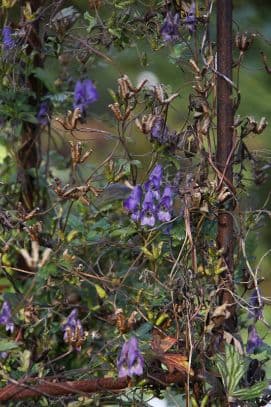Viticella Clematis Clematis 'Étoile Violette' (Vt)

ABOUT
Clematis 'Étoile Violette', often referred to simply as clematis, is a vibrant and showy climbing plant known for its profusion of flowers. The blooms are a deep, velvety purple with a nearly jewel-like quality. The individual flowers are made up of typically four to six broad, overlapping petals that taper to a point, creating a star-like shape, hence the name 'Étoile Violette' which means 'Purple Star' in French. At the center of each flower, a tuft of creamy-white or yellowish stamens provides a striking contrast to the purple petals, adding to the plant's allure. This clematis variety produces a generous number of blooms which cover the plant and can create a blanket of purple when in full flower. The leaves of 'Étoile Violette' are dark green and have a compound structure typical of clematis species, with each leaf made up of several smaller leaflets that provide a textured backdrop to the vibrant flowers. The foliage can have a glossy appearance, further highlighting the matte finish of the flower petals. Overall, the appearance of 'Étoile Violette' is one of robust beauty, with a cascading or climbing growth habit that allows for a dynamic presentation on garden structures like trellises, fences, or arbors. Its color and form make it a popular choice for gardeners looking to add a striking visual element to their landscape.
About this plant
 Names
NamesFamily
Ranunculaceae
Synonyms
Clematis ‘Étoile Violette’, Star Violet Clematis, Etoile Violette Clematis
Common names
Clematis 'Étoile Violette' (Vt)
 Toxicity
ToxicityTo humans
The Clematis is known to be toxic if ingested. It contains compounds called glycosides which can be harmful. Symptoms of poisoning may include mouth irritation, nausea, vomiting, diarrhea, and in severe cases, internal bleeding of the digestive system. Handling the plant can sometimes cause skin irritation due to its toxicity.
To pets
The Clematis plant is also toxic to pets. Ingesting the plant can lead to symptoms such as drooling, vomiting, diarrhea, and ataxia in pets. If a large enough quantity is consumed, it could potentially lead to more severe symptoms like internal bleeding or organ damage. Owners are advised to prevent their pets from consuming any part of the plant.
 Characteristics
CharacteristicsLife cycle
Perennials
Foliage type
Deciduous
Color of leaves
Green
Flower color
Violet
Height
6-8 feet (1.8-2.4 meters)
Spread
4 feet (1.2 meters)
Plant type
Climber
Hardiness zones
4
Native area
Europe
Benefits
 General Benefits
General Benefits- Ornamental Value: Clematis 'Étoile Violette' is a popular climbing vine due to its striking deep purple flowers that add aesthetic appeal to gardens and landscapes.
- Vertical Interest: As a climbing plant, it can cover trellises, walls, or pergolas, creating vertical interest in the garden and utilizing space effectively.
- Seasonal Interest: It blooms prolifically in the summer, providing color and vibrancy when many other plants have already finished flowering.
- Wildlife Attraction: The flowers attract pollinators such as bees and butterflies, contributing to the health of the garden ecosystem.
- Privacy Screen: When grown on fences or trellises, Clematis 'Étoile Violette' can provide privacy for outdoor spaces.
- Easy Pruning: Classified as pruning group 3, it can be pruned back hard at the end of winter, making it a low-maintenance choice for busy gardeners.
- Versatility: It can be planted in containers or in the ground, offering flexibility in garden design and suitability for small spaces or patios.
- Rapid Growth: It is a fast-growing vine that can achieve substantial coverage in a relatively short period.
- Hardiness: It is a hardy plant that can withstand cold temperatures, making it suitable for a variety of climates.
- Mixes well with other plants: It can be combined with other climbing plants or roses to create diverse and attractive plantings.
 Medical Properties
Medical PropertiesThis plant is not used for medical purposes.
 Air-purifying Qualities
Air-purifying QualitiesThis plant is not specifically known for air purifying qualities.
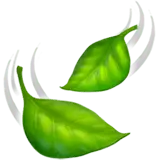 Other Uses
Other Uses- Clematis vines can be used as a natural privacy screen when grown on a trellis or fence, helping to create a secluded area in your garden.
- The woody structure of mature clematis can serve as support for other climbing plants, given that it's strong enough to hold additional weight.
- Dried clematis vines can be crafted into intricate wreaths or other forms of natural decor for the home or special events.
- The plant's rapid growth and dense foliage make it useful for covering up unsightly features in the landscape, like old stumps or utility boxes.
- When grown in containers on balconies or patios, clematis can add a vertical element of color and texture to small outdoor spaces.
- The vibrant flowers of the clematis can be used as a backdrop for photographing smaller plants or garden features.
- Gardeners can train clematis vines to grow into unique shapes or patterns for aesthetic garden designs.
- Clematis can be used in cut flower arrangements, though it's not as common, the blooms can add a dramatic flair to bouquets.
- On larger properties, clematis can be used to create a labyrinth or garden maze when grown on frames or arches.
- Clematis vines can serve as a natural habitat for beneficial insects, providing a home for pollinators and pest controllers.
Interesting Facts
 Feng Shui
Feng ShuiThe Clematis is not used in Feng Shui practice.
 Zodiac Sign Compitability
Zodiac Sign CompitabilityThe Clematis is not used in astrology practice.
 Plant Symbolism
Plant Symbolism- Mental agility: Clematis flowers, in general, are often associated with the mind and intellectual pursuits. The 'Étoile Violette' variety, with its starlike blooms and vibrant color, might symbolize the agility and vibrancy of thought.
- Artistic inspiration: Its striking deep purple hue can represent creativity and the muse of art, making 'Étoile Violette' a symbol for artistic inspiration and expression.
- Traveller's joy: Clematis is sometimes known as the traveller's joy, hinting at the plant's ability to thrive and climb, symbolizing exploration and adventure.
- Spiritual ascent: The plant's climbing nature may also represent spiritual or personal growth, with 'Étoile Violette' being a reminder of the journey towards enlightenment or higher states of being.
- Beauty and elegance: The 'Étoile Violette' clematis, with its star-shaped flowers, suggests beauty and elegance, making it a symbol for grace and charm in the plant kingdom.
 Water
WaterClematis 'Étoile Violette', commonly known as the Clematis, prefers consistently moist soil but not waterlogged. During the growing season, water the plant thoroughly once a week with about 1 gallon of water per plant. Adjust watering during hot, dry periods, providing additional water to keep the soil moist. In cooler weather or during rainy periods, reduce watering to prevent over-saturation of the soil. Always water the plant at the base to keep the foliage dry and reduce the risk of disease.
 Light
LightClematis 'Étoile Violette' thrives best in a location with full sun to partial shade. Ideally, provide the Clematis with about 6 hours of sunlight daily while offering some afternoon shade in areas with intense summer heat. The best spot for this plant is an area that receives morning sunlight and is protected from the harsh afternoon sun.
 Temperature
TemperatureClematis 'Étoile Violette' can tolerate a range of temperatures and is hardy in zones 4 through 8. The ideal temperature for growing Clematis is between 50°F and 68°F. They can survive temperatures down to about -30°F and can handle summer temperatures up to about 90°F as long as they are well-watered and have shaded roots.
 Pruning
PruningClematis 'Étoile Violette' should be pruned to encourage robust growth and abundant flowering. Prune in late winter or early spring before new growth begins, cutting the plant back to about 1 to 2 feet off the ground. This type of clematis blooms on new growth, so pruning will not affect flowering and is essential to prevent the plant from becoming too leggy.
 Cleaning
CleaningAs needed
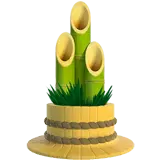 Soil
SoilThe best soil mix for Clematis 'Étoile Violette' is a well-draining, moisture-retentive loamy soil enriched with compost or well-rotted manure. The pH should be slightly alkaline to neutral, ranging from 7.0 to 7.5. It's important that the soil does not become waterlogged to prevent root rot, and mulching can help keep the root zone cool.
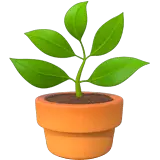 Repotting
RepottingClematis 'Étoile Violette' typically does not need frequent repotting, as it is a perennial plant that is usually grown outdoors. Repotting may be required every few years if grown in containers, to replenish soil nutrients and room for growth. Generally, repotting every 3-4 years is sufficient.
 Humidity & Misting
Humidity & MistingClematis 'Étoile Violette' performs best in outdoor conditions where it can receive natural humidity. Though specific humidity levels are not often regulated, it prefers moderate ambient humidity and can be sensitive to very dry conditions. Ensure it's planted in an area where it can benefit from morning dew and ambient moisture.
 Suitable locations
Suitable locationsIndoor
Ensure bright indirect light, cool root area.
Outdoor
Plant in full sun to part shade, mulch roots.
Hardiness zone
4-9 USDA
 Life cycle
Life cycleClematis 'Étoile Violette', commonly known as Viticella Clematis, begins its life cycle when a seed germinates in the spring, given ideal conditions of moisture and temperature. The seedling develops a root system and shoots that climb and support themselves on nearby structures or vegetation. As the plant matures, it produces long, woody vines with large, purple, star-shaped flowers that bloom from mid-summer to early autumn. After flowering, the plant produces feathery seed heads that disperse with the wind, potentially germinating to begin a new life cycle. In colder climates, Viticella Clematis dies back to the ground in winter, entering a period of dormancy, but the root system remains alive. With the return of warm weather in spring, the plant experiences new growth from the crown or existing nodes, continuing its perennial cycle.
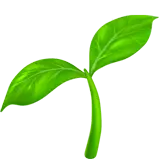 Propogation
PropogationPropogation time
Early spring
The most popular method of propagation for the Clematis 'Étoile Violette', often referred to simply as Clematis, is through layering, which is best done in late winter or early spring before the plant breaks dormancy. This process involves bending a stem to the ground and lightly scratching or wounding the part of the stem that contacts the soil, which encourages rooting. The wounded section is then covered with soil, usually about 2 to 4 inches (5 to 10 centimeters), and anchored down, often with a wire or a stone. To maintain moisture, the area can be mulched, and if desired, a rooting hormone can be applied to the wounded area to promote root growth. After a season or when sufficient roots have formed, the new plant can be severed from the parent and transplanted elsewhere in the garden.
